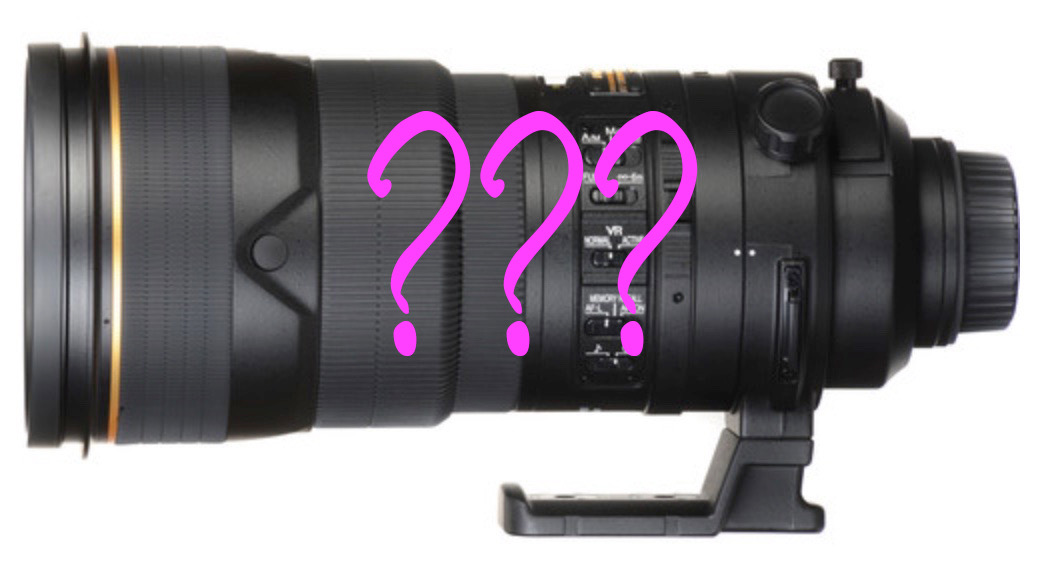
At one point in time, the best selling exotic lens was the 300mm f/2.8. All SLR and DSLR mounts had one as a result.
Today? Let's take a look:
- Canon RF — No 300mm f/2.8 (but 400mm f/2.8, 600mm f/4, 800mm f/5.6)
- Nikon Z — No 300mm f/2.8 (but 400mm f/2.8, 600mm f/4 on road map, 800mm f/6.3)
- Sony FE — No 300mm f/2.8 (but 400mm f/2.8, 600mm f/4)
Two factors seem to have come into play. First, the very good Sigma 120-300mm f/2.8 and excellent Nikon 120-300mm f/2.8 were introduced, and that provided flexibility while retaining the 300mm f/2.8 aspect. While the Nikon zoom was more expensive than the prime, I'd rather have it.
But more important, I think, has been that we moved from 300mm being about as much lens as you could handle without VR/IS (in the film era) to 300mm being a reasonable focal length for APS-C/DX DSLRs to...[crickets].
Today pretty much everything in the long telephoto range not only has some form of image stabilization, but that often works in conjunction with sensor-based stabilization. Couple that with full frame, lighter, smaller, more hand-holdable exotics, and it seems that 400mm f/2.8 is the new 300mm f/2.8, and longer is better (and available).
The birders are having their way with lens makers, it seems ;~).
Given my Z-mount proclivities these days and the fact that with telephoto I'm primarily a college sports and wildlife photographer, here's the way I now see my needs:
- 70-200mm f/2.8 tends to be used for indoor sports; on second body for large mammals close by.
- 120-300mm f/2.8 would be useful for football sidelines at some venues, some other sports (track and field); might suffice for second body large mammals close by.
- 400mm f/2.8 with built-in teleconverter gives me the 400mm and 560mm range I need for more removed sports access (lacrosse, soccer fields are large); perfect for the long lens on safari.
I wouldn't buy a 300mm f/2.8. I might buy something longer, such as an 800mm, but it would be rarely used.
I don't think I'm a lot different than other sports photographers. Even though I tend to use more modest focal lengths than other wildlife photographers, 300mm f/2.8 isn't something I find myself wanting. Perhaps if Nikon made a D500 DX replacement in the Z mount I might think differently (450mm f/2.8 effective is something I'd use). But for full frame? No.
To answer the headline, though, I'd say "no, just dormant." At some point, the camera makers will need to fill in their lens lineups with the full set of options so that they get all the potential sales, not just the most likely sales. We're a long way from the full exotic lineups that we had in the Canon EF and Nikon F mounts, which ranged from 200mm f/2 to 800mm f/5.6 (and even higher at times), with multiple aperture choices and some zooms sprinkled into the telephoto line as well. In what I call the exotic realm, Nikon had 200mm f/2, 300mm f/2.8 and f/4, 400mm f/2.8, 500mm f/4 and f/5.6, 600mm f/4, and 800mm f/5.6 primes, plus 120-300mm f/2.8 and 180-400mm f/4 zooms. That's ten exotics in the F-mount. Current Z-mount count? Three. Thus it's easy to guess that more are coming.
That said, I'd think that a 200mm f/2 and a 300mm f/2.8 would have lower priority with the Canikony lens teams at the moment than some other options that are still missing, particularly the aforementioned 120-300mm f/2.8 and the 200-400mm f/4 ranges (with built-in teleconverter).
So it may be awhile before you see a 300mm f/2.8. My best guess is that Canon would be first to so, and might do it by mostly porting over the existing EF lens (e.g. no major redesign).
_________________
Bonus: Fujifilm now needs a 300mm f/2.8 lens in the XF mount. But that's because they need to be competitive at the 400mm+ effective range (the X-H2S that really needs that lens is APS-C, so 300mm f/2.8 is 450mm equivalent f/2.8, bridging the gap between the full frame 400mm f/2.8 and 500mm f/4 lenses they'd be competing against.
